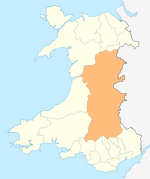Human settlement in Wales
Abbeycwmhir
| |
|---|---|
 | |
| Population | 235 |
| OS grid reference | SO055711 |
| Principal area | |
| Preserved county | |
| Country | Wales |
| Sovereign state | United Kingdom |
| Post town | LLANDRINDOD WELLS |
| Postcode district | LD1 |
| Post town | RHAYADER |
| Postcode district | LD6 |
| Dialling code | 01597 |
| Police | Dyfed-Powys |
| Fire | Mid and West Wales |
| Ambulance | Welsh |
| UK Parliament | |
| Senedd Cymru – Welsh Parliament | |
| 52°19′49″N 3°23′14″W / 52.3303°N 3.3871°W / 52.3303; -3.3871 | |
| This article needs additional citations for verification. Please help improve this article by adding citations to reliable sources. Unsourced material may be challenged and removed. Find sources: "Abbeycwmhir" – news · newspapers · books · scholar · JSTOR (September 2023) (Learn how and when to remove this message) |
Abbeycwmhir or Abbey Cwmhir (Welsh: Abaty Cwm Hir, "Abbey in the Long Valley") is a village and community in the valley of the Nant Clywedog in Powys, Wales. The community includes the hamlet of Bwlch-y-sarnau. It was historically in Radnorshire.
The Abbey
The village is named after Cwmhir Abbey, the Cistercian abbey built there in 1143. It was the largest abbey in Wales, but was never completed. Its fourteen bay nave was longer than Canterbury and Salisbury Cathedral naves and twice as long as that at St. Davids. It was a daughter house of Whitland Abbey, and was constructed at the behest of three sons of Madog, the then Prince of southern Powys. The first community at Dyvanner (Welsh: Ty faenor, "Manor House") failed because of the intervention of Hugh de Mortimer, Earl of Hereford, but in 1176 Rhys ap Gruffydd of Deheubarth re-established the Abbey on land given by Cadwallon ap Madog. Llywelyn ap Gruffudd is buried near the altar in the nave.
The abbey was burned by the forces of Owain Glyndŵr in 1401. At the time of the dissolution of the monasteries in March 1537, only three monks lived in the abbey.
The Abbey was slighted in 1644, during the English Civil War, although some ruins still remain. There is a memorial stone to Llywelyn ap Gruffudd, the last native Prince of Wales of direct descent, whose body is buried there.
Places of note

- The village church of St Mary was rebuilt in the Neo-Byzantine style by Mary Beatrice Philips in 1866. She was a granddaughter of Francis Philips, who purchased the Abbeycwmhir estate in 1837 with money from the cotton trade. It replaced a church built in 1680. Soon after the Victorian church was built, the writer Francis Kilvert visited.
- The Happy Union Inn is a Grade II listed building. Its age is unknown. The present owner is the third generation of his family to run the pub.
- Abbey Cwmhir Hall is a Georgian style house built in 1833 by Thomas Wilson, a London lawyer who had purchased the 3000 acre Abbeycwmhir estate. It is open to the public.
See also
References
- "Community population 2011". Retrieved 14 November 2015.
- "Abbey Cwm Hir". Abbey Cwmhir Heritage Trust. Abbey Cwmhir Heritage Trust. Retrieved 3 September 2019.
- "Abbey Cwmhir Hall". Hall Website. Archived from the original on 27 September 2007. Retrieved 17 August 2007.
